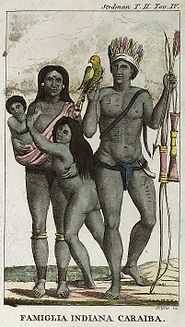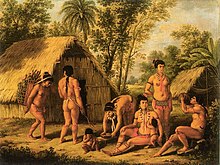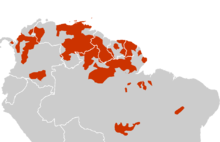Kalinago
Kalhíphona | |
|---|---|
 Carib family (by John Gabriel Stedman 1818) | |
| Total population | |
| |
| Regions with significant populations | |
| Dominica, Saint Lucia, Saint Vincent and the Grenadines, and Trinidad and Tobago; formerly throughout the Lesser Antilles | |
| Languages | |
| English, Dominican Creole French, formerly Island Carib | |
| Related ethnic groups | |
| Garifuna (Black Carib), Taíno |

The Kalinago, formerly known as Island Caribs[5] or simply Caribs, are an indigenous people of the Lesser Antilles in the Caribbean. They may have been related to the Mainland Caribs (Kalina) of South America, but they spoke an unrelated language known as Island Carib.[6] They also spoke a pidgin language associated with the Mainland Caribs.[6]
At the time of Spanish contact, the Kalinago were one of the dominant groups in the Caribbean (the name of which is derived from "Carib", as the Kalinago were once called). They lived throughout north-eastern South America, Trinidad and Tobago, Barbados, the Windward Islands, Dominica, and possibly the southern Leeward Islands. Historically, it was thought their ancestors were mainland peoples who had conquered the islands from their previous inhabitants, the Igneri. However, linguistic and archaeological evidence contradicts the notion of a mass emigration and conquest; the Kalinago language appears not to have been Cariban, but like that of their neighbors, the Taíno. Irving Rouse and others suggest that a smaller group of mainland peoples migrated to the islands without displacing their inhabitants, eventually adopting the local language but retaining their traditions of a South American origin.[7]
In the early colonial period, the Kalinago had a reputation as warriors who raided neighboring islands. According to the tales of
Name
The
The Kalinago language endonyms are Karifuna (singular) and Kalinago (plural).[13][14] The name was officially changed from 'Carib' to 'Kalinago' in Dominica in 2015.[15]
History
The Caribs are commonly believed to have migrated from the Orinoco River area in South America to settle in the Caribbean islands about 1200 CE, but an analysis of ancient DNA suggests that the Caribs had a common origin with contemporary groups in the Greater and Lesser Antilles.[16]
Pre-Columbian history
Over the two centuries leading up to
Caribs traded with the Eastern
In its early days, Daguao
The Kalinago produced the silver products found by Juan Ponce de León in Taíno communities. None of the insular Amerindians mined for gold but obtained it by trade from the mainland. The Kalinago were skilled boat builders and sailors. They appear to have owed their dominance in the Caribbean basin to their mastery of warfare.
Resistance to the English and the French

In the 17th century, the Kalinago regularly attacked the plantations of the English and the French in the Leeward Islands. In the 1630s, planters from the Leewards conducted campaigns against the Kalinago, but with limited success. The Kalinago took advantage of divisions between the Europeans, to provide support to the French and the Dutch during wars in the 1650s, consolidating their independence as a result.
In 1660, France and England signed the Treaty of Saint Charles with Island Caribs, which stipulated that Caribs would
Chief Kairouane and his men from Grenada jumped off of the "Leapers Hill" rather than face slavery under the French invaders, serving as an iconic representation of the Carib spirit of resistance.[24][25][26]
By 1763, the British eventually annexed St Lucia, Tobago, Dominica and St Vincent.[21]
Modern-day Kalinago in the Windward Islands
To this day, a small population of around 3,000 Kalinago survives in the Kalinago Territory in northeast Dominica. Only 70 of them considered themselves as pure.[27]
People


The Kalinago of Dominica maintained their independence for many years by taking advantage of the island's rugged terrain. The island's east coast includes a 3,700-acre (15 km2) territory formerly known as the
Several hundred Carib descendants live in the
During the beginning of the 18th century, the Island Carib population in
Religion
The Caribs are believed to have practiced
Currently, the remaining Kalinago in Dominica practice parts of Catholicism through baptism of children. However, not all practice Christianity. Some Caribs worship their ancestors and believe them to have magical power over their crops. One strong religious belief Caribs possess is that Creoles practice a style of indigenous spirituality that has witchcraft-like elements.[35] Creole people are Caribs mixed with those who settled the island. An example of said people are Dominican Creoles, who speak a mix of French and the native Carib language.
Cannibalism
The
The Caribs had a tradition of keeping bones of their ancestors in their houses.
During his third voyage to North America in 1528, after exploring Florida, the Bahamas and the Lesser Antilles, Italian explorer Giovanni da Verrazzano was killed and allegedly eaten by Carib natives on what is now Guadeloupe, near a place called Karukera (“island of beautiful waters”).[40] Historian William Riviere has described most of the cannibalism as related to war rituals.[41]
Medicine
The Kalinago are somewhat known for their extensive use of herbs for medicinal practices. Today, a combination of bush medicine and modern medicine is used by the Kalinago of Dominica. For example, various fruits and leaves are used to heal common ailments. For a sprain, oils from coconuts, snakes, and bay leaves are used to heal the injury. Formerly the Caribs used an extensive range of medicinal plant and animal products.[42]
Kalinago Canoes
Canoes are a significant aspect of the Kalinago's material culture and economy. They are used for transport from the Southern continent and islands of the Caribbean, as well as providing them with the ability to fish more efficiently and to grow their fishing industry. [43] Canoes, constructed from the Burseraceae, Cedrela odorata, Ceiba pentandra, and Hymenaea courbaril trees, serve different purposes depending on their height and thickness of the bark. The Ceiba pentandra tree is not only functional but spiritual and believed to house spirits that would become angered if disturbed. [44] Canoes have been used throughout the history of the Kalinago and have become a renewed interest within the manufacturing of traditional dugout canoes used for inter-island transportation and fishing. [45]
In 1997
The "Caribs"
The traditional account, which is almost as old as Columbus, says that the Caribs were a warlike people who were moving up the Lesser Antilles and displacing the original inhabitants. Modern research [47][page needed][48][page needed] has modified this in various ways.
Once the Cariban languages family was recognized, the “Caribs” came to be called "Island Caribs" or Kalinago, which is what they called themselves. The Island Caribs spoke a mixture of Carib and Arawak called the Kalinago language. (The Carib language proper is spoken in South America.) The original Arawakan inhabitants were the Igneri. They spoke an Arawakian language different from the Arawakian Taino language of the Greater Antillies.[citation needed]
They were accused of cannibalism. Despite rather lurid European accounts, this seems to have been mainly the ritual consumption of captured enemy warriors, a custom also found along the Brazilian coast.[citation needed]
The fact that they were warlike is supported by European accounts and by the fact that they held out beyond 1700 while the Arawaks of the Greater Antilles collapsed within a few decades of European arrival. In 1660 the French and English agreed to leave the islands of Dominica and Saint Vincent to the Caribs. On Saint Vincent they became mixed with runaway slaves, forming the ‘black Caribs’ or Garifuna who were expelled to Honduras in 1797. On Dominica the runaways formed distinct Maroon communities while the Caribs remained distinct. A remnant of these Caribs lives on in the Kalinago Territory.[citation needed]
They seem to have had the custom of attacking an enemy village, killing the men and keeping the women. This is supported by the fact that the Garifuna language is a mixture of Carib and Arawak, has different male and female forms and the male version has more Carib words.[citation needed]
Keegan and Hofman note that two models for the origin of the "Caribs" have been proposed. One model describes the Caribs as invaders entering the Antilles from South America shortly before the arrival of Europeans. The second model proposes that the Caribs developed out of the indigenous peoples of the Antilles. Archaeological evidence in support of either proposal is sparse, with "no confirmed Carib sites [known] prior to the 1990s." Cayo-style pottery (dated to 1000 to 1500) found in the Lesser Antilles, is similar to the Koriabo complex (from which the mainland Carib or
Notable Kalinagos
- president of Dominicasince 2023.
- Liam Sebastien
- Kellyn George
- Tobi Jnohope
- Fitz Jolly
- Garth Joseph
- Audel Laville
- Lester Prosper
- Julian Wade
- Jay Emmanuel-Thomas
See also
- Carib Expulsion
- Carib language
- Cariban languages
- Kalinago Genocide of 1626
- Santa Rosa Carib Community
References
- ^ "Dominica's Kalinago fight to preserve their identity". BBC News. 15 July 2018. Archived from the original on 15 September 2021. Retrieved 23 September 2022.
- ^ "World Directory of Minorities and Indigenous Peoples – St Vincent and the Grenadines". refworld. Archived from the original on 4 February 2020. Retrieved 23 September 2022.
- ^ "World Directory of Minorities and Indigenous Peoples – St Lucia". refworld. Archived from the original on 27 June 2017. Retrieved 23 September 2022.
- ^ "World Directory of Minorities and Indigenous Peoples – Trinidad and Tobago". refworld. Archived from the original on 27 May 2021. Retrieved 23 September 2022.
- ^ "Change from Carib to Kalinago now official". Dominica News Online. 2015-02-22. Archived from the original on 2016-03-08. Retrieved 2016-03-03.
- ^ a b c Haurholm-Larsen, Steffen (2016). A Grammar of Garifuna. University of Bern. pp. 7, 8, 9.
- ISBN 0300051816. Retrieved May 22, 2014.
Island Carib.
- ISBN 0300051816. Retrieved May 22, 2014.
- ^ "Study puts the 'Carib' in 'Caribbean,' boosting credibility of Columbus' cannibal claims".
- ^ a b Jennifer, Ouellette (December 29, 2020). "Did Columbus find early Caribs in 15th century Caribbean? Jury is still out". Ars Technica. Archived from the original on February 3, 2024.
- ^ JSTOR j.ctt24hxr2.
- S2CID 144195511.
- JSTOR 1519956.
- JSTOR 40654135.
- ^ Admin (2015-02-22). "Change from Carib to Kalinago now official". Dominica News Online. Retrieved 2023-05-24.
- PMID 25487339.
- ^ Sweeney, James L. (2007). "Caribs, Maroons, Jacobins, Brigands, and Sugar Barons: The Last Stand of the Black Caribs on St. Vincent" Archived 2012-02-27 at the Wayback Machine, African Diaspora Archaeology Network, University of Illinois, Urbana-Champaign, March 2007, retrieved 26 April 2007
- ISBN 978-1438108315.
- ISBN 978-0300133899.
- ^ "La historia de Puerto Rico a través de sus barrios: Daguao de Naguabo (The history of Puerto Rico through its barrios: Daguao in Naguabo)" (video). www.pbslearningmedia.org (in Spanish). Fundación Puertorriqueña de las Humanidades. Retrieved 29 August 2020.
- ^ a b Hilary Beckles, "The 'Hub of Empire': The Caribbean and Britain in the Seventeenth Century", The Oxford History of the British Empire: Volume 1 The Origins of Empire, ed. by Nicholas Canny (Oxford: Oxford University Press, 2001), p. 234.
- ^ Floyd, Troy S. (1973). The Columbus Dynasty in the Caribbean, 1492-1526. University of New Mexico Press. p. 135.
- OCLC 48617879.
- S2CID 163455608.
- ^ Crouse, Nellis Maynard (1940). French pioneers in the West Indies, 1624–1664. New York: Columbia university press. p. 196.
- ^ Margry, Pierre (1878). "Origines Francaises des Pays D'outre-mer, Les seigneurs de la Martinique" [French origins of overseas countries, the lords Martinique]. La Revue maritime (in French): 287–8.
- ^ "Refworld | World Directory of Minorities and Indigenous Peoples - Dominica : Caribs".
- ISBN 9780066210865.
- ^ "Kalinago People | | a virtual Dominica". Archived from the original on October 26, 2010.
- ISBN 9682323657– via Google Books.
- ISBN 9781617033100– via Google Books.
- ISBN 9780906522219– via Google Books.
- ^ Menhinick, Kevin, "The Caribs in Dominica" Archived 2012-03-03 at the Wayback Machine, Copyright © Delphis Ltd. 1997–2011.
- ^ Puerto Rico. Office of Historian (1949). Tesauro de datos historicos: indice compendioso de la literatura histórica de Puerto Rico, incluyendo algunos datos inéditos, periodísticos y cartográficos (in Spanish). Impr. del Gobierno de Puerto Rico. p. 238. Retrieved 4 January 2020.
- ^ "Carib, Island Carib, Kalinago People (Anthropology)". Retrieved 2019-03-23.
- ^ Harper, Douglas. "Cannibal". Online Etymological Dictionary. Archived from the original on 12 February 2015. Retrieved 12 February 2015.
- .
- ^ Johnson, Stephen (July 6, 2023) [August 30, 2021]. "Controversy: Was the Caribbean really invaded by cannibals?". BIg Think. Archived from the original on February 3, 2024.
- ^ Puerto Rico. Office of Historian (1949). Tesauro de datos historicos: indice compendioso de la literatura histórica de Puerto Rico, incluyendo algunos datos inéditos, periodísticos y cartográficos (in Spanish). Impr. del Gobierno de Puerto Rico. p. 22. Retrieved 4 January 2020.
- ISBN 0-300-01207-1.
- ^ Historical Notes on Carib Territory Archived 2011-10-06 at the Wayback Machine, William (Para) Riviere, PhD, Historian.
- ^ Regan, Seann. "Healthcare Use Patterns in Dominica: Ethnomedical Integration in an Era of Biomedicine". Archived from the original on April 22, 2019. Retrieved April 22, 2019.
- ^ "Canoe Building". Indigenous Kalinago People of Dominica.
- S2CID 213414242.
- ^ Honychurch, Lennox (1997). Carib to Creole: contact and culture exchange in Dominica. University of Oxford.
- ^ "Quest of the Carib Canoe". Archived from the original on 2013-09-11. Retrieved 2013-09-05.
- ^ Sebastian Lamarche, Tainos and Caribs, 2019
- ^ Granberry and Vescelius, The Languages of the Pre-Columbian Antillies, 2004
- ^ Keegan & Hofman 2017:232–233
- ^ Keegan & Hofman 2017:234
Sources
- Keegan, William F.; ISBN 9780190647353.
Further reading
- Patrick Leigh Fermor, The Traveller's Tree, 1950, pp. 214–5
- Puerto Rico. Office of Historian (1949). Tesauro de datos historicos: indice compendioso de la literatura histórica de Puerto Rico, incluyendo algunos datos inéditos, periodísticos y cartográficos (in Spanish). Impr. del Gobierno de Puerto Rico. p. 22. Retrieved 4 January 2020.
- Allaire, Louis (1997). "The Caribs of the Lesser Antilles", in Samuel M. Wilson, The Indigenous People of the Caribbean, pp. 180–185. Gainesville, Florida: University of Florida. ISBN 0-8130-1531-6.
- Steele, Beverley A. (2003). Grenada, A history of its people, New York: Macmillan Education, pp. 11–47
- Honeychurch, Lennox, The Dominica Story, MacMillan Education, 1995.
- Davis, D and Goodwin R.C. "Island Carib Origins: Evidence and non-evidence", American Antiquity, vol.55 no.1(1990).
- Eaden, John, The Memoirs of Père Labat, 1693–1705, Frank Cass, 1970.
- (in French) Brard, R., Le dernier Caraïbe, Bordeaux : chez les principaux libraires, 1849, Manioc : Livres anciens | L E dernier caraïbe. Bordeaux.
External links
- Quest of the Carib Canoe - documentary [1]
- The Quest of the Carib Canoe - dead link.
- Mainland Carib artwork, National Museum of the American Indians
- Yurumein (Homeland): A Documentary on Caribs in St. Vincent
- Guanaguanare - the Laughing Gull. Carib Indians in Trinidad - includes 2 videos
- "Carib", Ethnologue
- "Kalinago", Name change announcement of November 15, 2010, by the Office of the Kalinago Council posted at Dominica News Online
